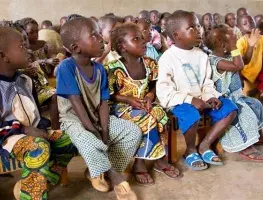Request tailored, remote support on child protection coordination, information management, and thematic areas.
Demander un soutien à distance sur mesure pour la coordination de la protection de l'enfance, la gestion de l'information et les domaines thématiques.
Solicite asistencia remota sobre coordinación en Protección de la Niñez, gestión de la información y otras áreas temáticas.
قم بطلب دعم مخصص عن بعد في أي من مجالات تنسيق حماية الطفل وإدارة المعلومات أو أي من مواضيع حماية الطفل الأخرى.
Burkina Faso
L2Le Burkina Faso est confronté à une crise sévère de protection d’une grande complexité due aux activités croissantes des groupes armés et aux tensions intercommunautaires posant de considérables risques de sécurité. La multiplication des attaques violentes contre les civils par les groupes armés non étatiques dans les différentes localités des régions du Nord, du Centre Nord, de l’Est, du Sahel, de la Boucle de Mouhoun avec des corollaires dans le Centre-Est et le pays dans son ensemble souvent avec l’utilisation des enfants et obligeant des villages entiers à se vider de leurs populations, illustre la gravité de la situation.
Entre février 2017 et avril 2022, plus de 1 902 150 personnes ont été contraintes de fuir leur domicile pour trouver refuge dans d’autres zones mieux sécurisées (voire données du Conseil National des Secours d’Urgence et Réhabilitation « CONASUR » en fin avril 2022). Ces personnes sont arrivées dans des localités où les infrastructures de base étaient quasi inexistantes, notamment les formations sanitaires et les écoles qui pour la plupart sont fermées du fait de la violence. Selon le rapport statistique mensuel de données d’Education en Situation d’Urgence, 4 258 établissements scolaires ont été fermés au 31 mai 2022 (secrétariat technique de l’éducation en situation d’urgence, mai 2022).
Dans ces situations d’urgence, les enfants, les jeunes et les femmes sont les plus vulnérables du fait de l’affaiblissement des mécanismes de protection traditionnels. Les filles et les garçons sont exposées aux différentes formes de violence, aux mariages d’enfants, aux MGF, à la non-scolarisation, à la mendicité et au chômage. La fragilité du contexte sécuritaire dans ces régions réduit fortement leurs opportunités d’accès aux services de base.
En référence au plan de réponse humanitaire de 2022 du Burkina Faso, plus de 3,5 millions des personnes sont dans le besoin pour 3 millions ciblées par l’assistance humanitaire, dont plus de 60% sont des enfants. Sur le plan sectoriel, 928 milles d’enfants sont dans les besoins en 2022 dont 374 milles sont ciblés pour la réponse (soit environ 40% du PiN).
Cette plateforme est un espace où le CPAoR assure la diffusion des documents et événements clés, suivi de la réponse et autres produits d'information spécifiques aux questions de protection de l’enfant dans le contexte humanitaire au Burkina Faso.
Key Figures
2024 Response plan in numbers
Country Overview
Burkina Faso faces a rapidly deteriorating humanitarian situation. Attacks by non-state armed groups increased dramatically in 2019 and continued in 2020. More civilians are being targeted or threatened. As of 23 August 2020, the country had recorded 337 security incidents since the start of the year, causing 575 civilian casualties, including 28 children. As a result, new waves of displacement continue in several regions. According to CONASUR, as of November 10, 2020, the country has registered 1,049,767 IDPs of which 55% are children (0-14 years) and nearly 53% female. The number of IDP children increased from 300,000 as of December 9, 2019 to 534,894 as of November 10, 2020. 22% of IDPs live with host families with access to health care, water, sanitation, hygiene and child protection services are inadequate. The most affected regions are the Center-North, followed by the Sahel, the North, the East, the Center-East and the Boucle de Mouhoun. In addition to the security situation, the country is also facing flooding due to torrential rains and events that have exacerbated the situation of the already precarious population. In 2020, at least 106,228 including 60,433 children were affected by floods and strong winds causing 41 deaths, 112 injuries and 12,378 residential houses destroyed. In addition, although the country has been slightly impacted so far by the COVID-19 pandemic, the risk exists and could have serious health and social consequences if it were to strike the populations affected by the crisis. safe.

